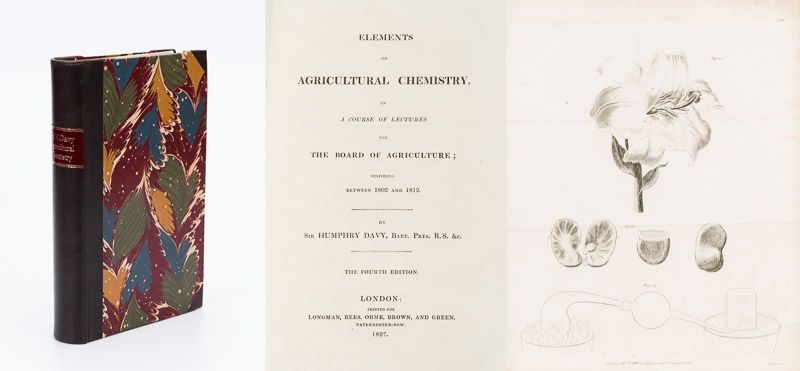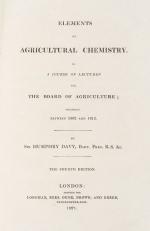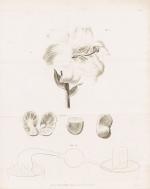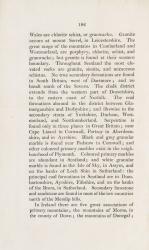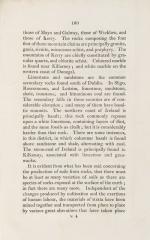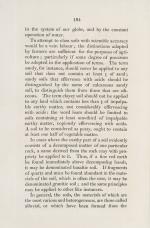Davy, Elements of Agricultural Chemistry - In a Course of Lectures delivered bef
Elements of Agricultural Chemistry – In a Course of Lectures delivered before the Board of Agriculture [With an Appendix: “An Account of the Results of Experiments on the Produce and nutritive Qualities of different Grasses and other Plants, used as the Food of Animals” – Instituted by John Duke of Bedford].
The Fourth Edition. Londo, Longman, Rees, Orme, Brown and Green, 1827. Large Octavo. X, (1), 403 pages with 10 fold-out plates, showing experiments in Botany and Agricultural Chemistry like Thomas Andrew Knight’s Water Wheel, which applied Gravity to Seedlings. Hardcover / The original book-block was recently bound in a stunning new half – leather with marbled-paper-covered boards, bound to style of an early 19th-century binding with a new spine-label. Excellent condition.
Plates included in this work:
Plate I – Shows the Gravitation Experiment by Thomas Andrew Knight:
Shows two Gravitation-Wheels with vertically and horizontally fixed seeds
Plate II – Shows Experiments by Ambroise Marie François Joseph Palisot, Baron de Beauvois and
Charles-François Brisseau de Mirbel: Shows Palisot de Beauvois – Experiment on lime-tree, Maple and Lilac
as well as Mirbel’s idea of the simple porous tube
Plate III – Plate IV – Plate V
These plates all show an Experiment with an Elm Branch, an Oak Branch and the Branch of an Ash Tree
Plate VI – “represents part of a leaf of a vine magnified and cut, so as to exhibit the tracheae″
Plate VII – shows three figures:
a. “Figure 12 represents the common lily with corolla and anthers and pistil″
b. “Figure 13 represents the garden bean with cotyledons and plume and radicle″
c. “Figure 14 shows an apparatus “to make correct experiments on the decomposition of vegetable substances by heat″
Plate VIII – shows Figure 15: “represents the different parts of this Apparatus″
Plate IX – shows Figure 16: “Large folding Plate which gives “a general idea of the appearance and arrangement of Rocks and Veins [Sediments]” [Davy taks here alsoa about the different Rock and Sediment-structures of Granite at Mount Sorrel in Leicestershire, compares it to Mountains in Cumberland, mentions Scotland and Ireland and the most common Rock structures there. For Ireland he mentions the Mountains of Morne in County Down and the Mountains of Donegal, County Mayo and Galway, those of Wicklow and thos of Kerry. He also mentions the coloured marble found near Killarney and white Marble found on the wetsern coast of Donegal.
Limestone in Dublin, Sligo, Roscommon and Leitrim are mentioned.
Plate X – shows a large growing Experiment under Glass
Sir Humphry Davy, 1st Baronet, FRS, MRIA, FGS (17 December 1778 – 29 May 1829) was a British chemist and inventor who invented the Davy lamp and a very early form of arc lamp. He is also remembered for isolating, by using electricity, several elements for the first time: potassium and sodium in 1807 and calcium, strontium, barium, magnesium and boron the following year, as well as for discovering the elemental nature of chlorine and iodine. Davy also studied the forces involved in these separations, inventing the new field of electrochemistry. Davy is also credited to have been the first to discover clathrate hydrates in his lab.
In 1799 he experimented with nitrous oxide and was astonished at how it made him laugh, so he nicknamed it “laughing gas” and wrote about its potential anaesthetic properties in relieving pain during surgery.
Davy was a baronet, President of the Royal Society (PRS), Member of the Royal Irish Academy (MRIA), Fellow of the Geological Society (FGS), and a member of the American Philosophical Society (elected 1810). Berzelius called Davy’s 1806 Bakerian Lecture On Some Chemical Agencies of Electricity “one of the best memoirs which has ever enriched the theory of chemistry.″
Davy seriously injured himself in a laboratory accident with nitrogen trichloride. French chemist Pierre Louis Dulong had first prepared this compound in 1811, and had lost two fingers and an eye in two separate explosions with it. In a letter to John Children, on 16 November 1812, Davy wrote: “It must be used with great caution. It is not safe to experiment upon a globule larger than a pin’s head. I have been severely wounded by a piece scarcely bigger. My sight, however, I am informed, will not be injured”. Davy’s accident induced him to hire Michael Faraday as a co-worker, particularly for assistance with handwriting and record keeping. He had recovered from his injuries by April 1813.
Davy’s passion for fly-fishing earned him the informal title “the father of modern fly-fishing”, and his book Salmonia is often considered to be “the fly-fisherman bible.
- Keywords: 19th Century – Rare · 19th century agriculture · Agricultural Chemistry · Agricultural ecology · Agriculture · Botany · Botany – Rare · Chemistry · Chemistry – Rare · Forage Plants · Grass · Grasses · Natural History · Natural History – Rare · Plants · Poaceae or Gramineae · Science – Rare
- Language: English
- Inventory Number: 31417AB
EUR 675,--
© 2024 Inanna Rare Books Ltd. | Powered by HESCOM-Software





